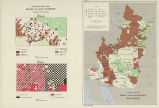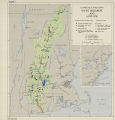| OCR Text |
eral public because transportation savings can be reflected directly on the prices paid by the con- sumers of transported goods. In certain cases local benefits also accrue, such as from land enhance- ment or the stimulation of local business and em- ployment. Where local benefits are involved, costs are divided between the United States and local interests in the relation of the general to the local benefits. The costs assigned to local interests are met at the time of project construction, usually by contributions of rights-of-way, spoil disposal areas, bridge and utility revisions, and in some cases, where warranted, a cash payment toward the project con- struction cost. Local interests are also required to maintain project depths in small harbors. In ac- cordance with the national policy of promoting commerce between the States, Federal costs of navi- gation projects are not considered reimbursable. Since no tolls or other direct monetary charges are made, no repayment of any navigation improve- ment costs is in prospect, nor is there any direct in- come from operation. Flood Control Early floods in the basin caused relatively little known damage because of limited settlement in the overflow areas. As development on lands sub- ject to floods has increased, flood losses have kept pace. The general trend culminated in the flood catastrophe of 1948 which caused the loss of 50 lives and 100-million-dollar damage.4 Had the maximum recorded flood (that of 1894) occurred under present conditions of development it is estimated tliat the loss would have reached 350 million dollars. Analysis of flood possibilities in the basin indicate that future flood damages will average 35.5 million dollars annually if there are no further provisions for flood control. The over--all cost of flood control in the basin cannot be determined because cost allocations have not been completed for the various phases of many multiple-puxpose projects. Since divisions of cost are not available in all instances it is impossible to present data, on the over-all benefit-cost ratio of the flood control program. However, the Corps of Engineer-s reports that in all cases the flood control feature has been examined in sufficient detail to establish justification for its inclusion, at The largest single losses were at the very vulnerable Vanport site near Portland, Oreg. the time of the establishment of economic justifica- tion for the multiple-purpose development. Flood control improvements are established by Congress as being in the interest of general welfare and, therefore, warranting participation by the United States in their costs. Since no direct Fed- eral revenue accrues as a result of flood control improvements, records of the benefits realized from the improvements are maintained only for the pur- pose of a check on their actual accomplishments.5 In the case of local flood protection projects 6 on the Columbia, local interests are generally re- quired to: (1) provide without cost to the United States all lands, easements, and rights-of-way neces- sary for the construction of the project; (2) hold and save the United States free from damages due to the construction work; and (3) maintain and operate all the works after completion in accord- ance with regulations prescribed by the Secretary of the Army. Payment for any enhancement of land values which result from construction in some cases also may be required.7 Local interests are asked to furnish a cash contribution toward the construction cost, in addition to meeting the fore- going minimum requirements, when a significant measure of the benefits are local in character. The Corps of Engineers reports that in the Colum- bia River Basin, local participation in the con- struction cost of all existing flood protection proj- ects (exclusive of multiple-purpose reservoirs) has been over 40 percent of total project costs. In the local protection projects, local interests are also required to bear the annual cost for maintenance and operation. Multiple-purpose reservoirs, how- ever, constitute major expenditures in the future flood control program for the Columbia, with 75 percent of the construction cost, on the average, allocated to power. There is no local contribution to their construction, except as users of electric energy return the investment through their pay- ment for energy. 8 These records for existing improvements are pub- lished in the annual report of the Chief of Engineers, U. S. Army. 6 Local flood protection projects are taken not to include any dam or reservoir project to which the suc- ceeding three requirements do not apply. The succeed- ing three conditions apply to local projects authorized in 1936 or later years. Channel and channel rectification projects authorized in the Flo.od Control Acts of 1936 and 1938 are exempted from the requirements. 7 Estimates are made in advance of construction and obligations from enhancement are payable in advance of construction. 32 |


























































































































































































































































































































































































































































































































































































































































































































































































































































